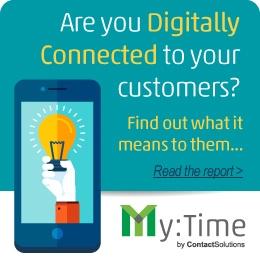Have you noticed how dramatically the devices that surround us in the digital mesh have changed how we communicate? Of course you have. Digital technology has altered the way we all live and behave. What does that mean for customer engagement?
 Instead of engaging in a long conversations from start to finish, consumers today are far more inclined to message in short, stop-and-go segments. They text and tweet, post short updates on social media, send quick pix via Snapchat, and rely on dozens of other messaging apps. And they do it all while they're constantly on the move, switching from one device to another as they go about their business.
Instead of engaging in a long conversations from start to finish, consumers today are far more inclined to message in short, stop-and-go segments. They text and tweet, post short updates on social media, send quick pix via Snapchat, and rely on dozens of other messaging apps. And they do it all while they're constantly on the move, switching from one device to another as they go about their business.
Why then, do so many enterprises rely so heavily on customer engagement solutions that create an experience designed for the pre-digital age? Though not advertised this way, these pre-digital engagement solutions:
- Treat each customer customer engagement as a separate, discrete episode, forcing customers to repeat the same information when re-engaging.
- Hold customers hostage until the issue is resolved, wasting their valuable time and forcing them to make an effort to "pay attention" from start to finish of the session.
- Consider engagement from exploration to closure separately across different channels or devices.
In short, it’s the “once and done” model. And, when you employ it, your customers have to start all over if interrupted or transferred.
“But we have omni-channel!” you say. “This cannot be so!”
Unfortunately, the reality is not what you’ve been led to believe.
As the Director of Innovation at Contact Solutions, my focus is on optimizing the processes to determine the balance between technology incubation, research, and education. I’m an IT guy with strategy chops. I live and breathe digital engagement technology. And the perception of omni-channel I see is rarely aligned with reality.
Omni-channel customer care is not digital engagement
Omni-channel solutions consist of multiple closed communication protocols often not able to transfer real context as your customers move among them. That’s why we treat omni-channel engagement channels as auxiliary; in other words, to be used only when live communication is necessary. But most often, it’s not. When messaging technology is IP based, rich content can be shared regardless of time and the device in use.
Once a customer starts an interaction, why do they have to pay attention every moment while it's being resolved? Shouldn't they be able to get on with their busy lives and pay attention to other things, confident that the enterprise has picked up their interaction and is working on it? It’s not an unreasonable request. And it doesn’t stop with the customer.
A digital customer engagement experience should mirror today’s mobile and digital lifestyle: Don’t make me wait!
Traditional customer engagement can be frustrating and inefficient for representatives, too. Without context and history around a customer request, the company representative spends too much time gathering basic information before addressing the issue. Because customer expectations have changed—customers expect things more immediately than ever before—today’s typical customer engagement environment of waiting irritates the customer:
- I wait to reach the next available representative.
- I wait while the representative identifies your needs.
- I wait for a response while the representative juggles multiple chats.
- I wait while the issue is escalated to another level.
- I think, Why does the company believe its time is more important than mine??
 An irritated customer is already primed for dissatisfaction. Unfortunately, the traditional chat offering enterprises have chosen in the past perpetuate the exact same scenario across channels.
An irritated customer is already primed for dissatisfaction. Unfortunately, the traditional chat offering enterprises have chosen in the past perpetuate the exact same scenario across channels.
This no longer must be the case. Customers prefer to present the problem, and they expect it will be resolved fast, without waiting. Guess what?! That is possible right now…with messaging!
The old ways of interacting with (and irritating) customers affects the productivity and satisfaction of company representatives. Phone and web chat tend to funnel inquiries to representatives, distracting them from seeing complex customer issues through completion. As a result, representatives flip-flop from one customer to the next, many times without any digital context of an individual’s needs.
Using mobile messaging for digital customer engagement
Messaging inherently keeps the customer and support representative in context until the case is resolved. This builds a greater sense of satisfaction with the company representatives and real congruency with customer needs. What’s more, this makes the new tech approach more like it used to be in brick and mortar businesses where you interacted with one person for long periods of time, building confidence not only in the representative, but in the brand and service they offer:
- When you know a consistent support representative is working the problem even after the initial engagement feels like someone is looking out for you.
- When the need for a consistent representative is not critical to the engagement model—but representative visibility to historical messaging, context, and interaction steps are—customers can receive the same high-touch continuity of care and support.
We don’t live in 1998. Digital engagement solutions should allow the customer to present the problem and have confidence that…even when not connected in a live engagement…someone is working to resolve the issue.
Read more about digital customer engagement in our report "Are you Digitally Connected to your Customers?"



